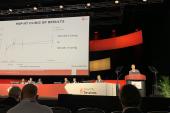Telemedicine Strategy After MI Scores a Win in TELE-ACS
Patients went home with self-testing devices plus remote access to a cardiologist—readmissions, events, and symptoms improved.

ATLANTA, GA—A telemedicine-based approach to care after acute coronary syndromes can reduce readmissions to the hospital, visits to the emergency department (ED), and the rates of stroke and MI, according to results from the randomized TELE-ACS trial. Notably, use of the management strategy also was linked a reduction in patient-reported symptoms.
“MI remains one of the leading causes of mortality in the UK despite cutting-edge medical and interventional therapies,” said Nasser S. Alshahrani, MSc (Imperial College London, England, and King Khalid University, Abha, Saudi Arabia), presenting the data at the recent American College of Cardiology (ACC) 2024 Scientific Session. Moreover, around 10% of patients return to the hospital within 30 days of their event.
TELE-ACS, said Alshahrani, was designed to see if “a novel telemonitoring system-based algorithm would reduce hospital readmissions for patients post-ACS by using well-validated technologies coupled with an urgent remote consultation with a cardiologist.”
One question at the outset was whether the remote monitoring would provide enough information to guarantee clinicians could effectively assess patients without necessitating a face-to-face encounter, he said. The results, simultaneously published in the Journal of the American College of Cardiology, suggest the answer to that is yes.
ACC President Cathleen Biga, MSN, RN (Cardiovascular Management of Illinois, Woodridge), said she was struck by this trial and others at the meeting that focused on transformation of care delivery. So much of medicine has “evolved, yet our quality hasn’t gotten better,” Biga commented. “We have got to figure out a different way of caring for our patients because our MI readmission rate, our 30-day mortality after an acute coronary syndrome, the needle isn’t moving. So what are we going to do differently to help move that needle?”
Biga said the TELE-ACS trial speaks to the possibilities that a remote approach could continue to offer MI patients in today’s practice.
The COVID-19 pandemic abruptly upended care back in 2020, Biga pointed out. “We went completely telehealth in 12 hours, . . . before we opened our office that Monday. We changed in a nanosecond.” Then, as the world grew more used to the virus, “we went right back to packed waiting rooms [and] in-person visits,” she noted.
Telemedicine vs Usual Care
Alshahrani and colleagues analyzed data for 337 patients (mean age 58.1 years; 86% male; 46% white) with at least one cardiovascular risk factor who had been hospitalized with ACS between January 2022 and April 2023. Three-quarters had hypercholesterolemia, nearly 60% were smokers or had a history of smoking, around half had hypertension, four in 10 had a family history of CAD, and a little more than a quarter had diabetes.
Prior to discharge, the patients were randomized to receive either telemedicine-based or standard care; to participate, they had to have access to a smartphone or other smart device.
In the intervention group, patients received a telemonitoring package consisting of a 12-lead ECG belt (SHL SmartHeart; SHL Telemedicine), an automated blood-pressure monitor (Omron Basic M2; Omron Corporation), and a pulse oximeter (Kinetik Wellbeing), as well as training in how to use the devices. They also received follow-up phone calls for training at 2, 4, and 8 weeks.
When these patients felt symptoms they thought were potentially cardiac, they used their telemonitoring tools, with the details transmitted to a cardiologist. The cardiologist performed remote clinical assessment and then triaged patients to receive either reassurance with clinical follow-up as previously planned or advice to contact their general practitioner, go to the ED for further testing, or call emergency services. Cardiologists based their decision-making on an algorithm that categorized symptoms and clinical parameters. Remote consultations were available from 7 AM to 11 PM on weekdays; outside of these time frames, or if they didn’t hear from a cardiologist within 15 minutes of reporting their symptoms, patients were meant to seek medical advice through the usual clinical pathways.
In the control arm, patients sought medical advice through the usual pathways and received standard routine clinical care, with remote, phone-based follow-up at 3, 6, and 9 months.
We have got to figure out a different way of caring for our patients, because . . . the needle isn’t moving. Cathleen Biga
Study participants made a total of 169 calls, 64% of them during the active hours on weekdays. Reported symptoms were most often chest pain/discomfort, followed by palpitations and general weakness.
Of the 108 calls during the active hours, 54.6% resulted in patients receiving reassurance. Another 26.9% were advised to visit their general practitioner, 13.9% told to visit the ED, and 4.62% recommended to call emergency services.
By 6-month follow-up, there were 20 readmissions with telemedicine and 50 with standard care. Thus, the time to readmission (primary endpoint) was reduced with the remote strategy, as were visits to the ED and MIs. Stroke trended lower, though the rate of all-cause death was identical in the two groups.
Six-Month Outcomes in ACS Patients
|
|
Telemedicine |
Control |
HR (95% CI) |
|
Readmission |
8% |
29% |
0.24 (0.13-0.44) |
|
ED Visit |
24% |
37% |
0.59 (0.40-0.89) |
|
MI |
7% |
22% |
0.27 (0.14-0.53) |
|
Stroke |
2% |
5% |
0.38 (0.10-1.42) |
|
All-Cause Death |
1.2% |
1.2% |
1.03 (0.15-7.31) |
Moreover, patients in the telemedicine group had fewer unplanned coronary revascularizations than did controls (3% vs 9%) and were less likely to report chest pain (9% vs 24%), breathlessness (21% vs 39%), and dizziness (6% vs 18%).
Telemonitoring in the active study arm ceased at 6 months. Notably, though, “the initial effect between 0 to 6 [months] was large enough to leave a legacy effect up to 9 months,” Alshahrani said.
At 9-month follow-up, hospital readmissions still were less common with the intervention than with usual care (HR 0.35; 95% CI 0.21-0.59). So, too, were visits to the emergency department (HR 0.66; 95% CI 0.46-0.94) and the rate of invasive coronary angiography and/or angioplasty (4% vs 10%; P= 0.03). However, there was no longer a difference in symptoms between the two groups.
Alshahrani, in his presentation, cited several limitations to their study. Among them were its predominately male population, the potential for recall bias due to retrospective collection of symptom data, and the fact that participants were required to have access to a smartphone.
Additionally, “the high level of support for the telemedicine group, with prompt cardiology responses, may be challenging to replicate outside a trial setting, requiring significant investment and training,” he continued, while “technological barriers and infrastructure requirements may pose some obstacles to implementation. . . . Further studies need to establish the feasibility of implementation in different healthcare systems.”
We were surprised by the large effect. Nasser S. Alshahrani
Malissa Wood, MD (Lee Health Heart Institute, Fort Myers, FL), discussant for the TELE-ACS results, highlighted the decrease in MI with monitoring. “Do you think the intervention was related to that, as far as the patients knowing that they were being monitored or that they could reach out to someone? Did you look at any psychosocial variables to see if that reduced stress, anxiety, or depression in that population that may have been related to that reduction in myocardial infarction?”
“We were surprised by the large effect, and it could be because of the high level of support that we delivered and also the patient education on symptoms at the point of contact” and then at regular intervals thereafter, Alshahrani explained. “It could be the Hawthorne effect: when the patient is monitored, they tend to change their behavior.”
For ease of use, Wood suggested that going forward it would be good to have a device that incorporates all three measurements—oxygen saturation, blood pressure, and ECG readings—“so you don’t have the patient having to [use] all these different devices to transmit data.”
Biga, speaking with TCTMD, said that much of the positive impact in TELE-ACS may come from the fact that telemedicine offered a way to connect regularly with a human touch, albeit remote, that was reassuring but also offered practical advice and “constant education.” This can be valuable for patients feeling overwhelmed by the intricacies of their care after discharge, she said.
As Biga noted, the challenge lies in how to implement the strategy. Patients may prefer to call their own doctor’s office over a less-familiar hotline, and any added personnel or other resources to handle these calls must be paid for. The most convenient, cost-effective option going forward might be third-party companies to streamline remote monitoring, she added, “so the practices don’t carry the burden, because the payment from [Medicare for] remote patient monitoring isn’t going to begin to cover the cost of that: you have the equipment and the intellectual property.”
Scaling up is tricky, especially with the “tsunami of data,” Biga stressed. In just one of her practices, Biga said, 900 patients are seen a day—more than five times the number of participants in the intervention arm of TELE-ACS. The real-world math is daunting, she pointed out. “How many MIs do I have a month? Can I get them all hooked up and compliant and have the staff to analyze that data?”
Caitlin E. Cox is News Editor of TCTMD and Associate Director, Editorial Content at the Cardiovascular Research Foundation. She produces the…
Read Full BioSources
Alshahrani NS, Hartley A, Howard J, et a. Remote acute assessment of cardiac patients post-acute coronary syndrome (TELE-ACS): a randomized controlled trial. J Am Coll Cardiol. 2024;Epub ahead of print.
Disclosures
- This work was funded by the British Heart Foundation; King Khalid University via the Saudi Arabian Cultural Bureau; Sansour Fund, Imperial Healthcare Charity; and Safwan Sobhan Fund at Imperial College London.
- Alshahrani reports no relevant conflicts of interest.





Comments